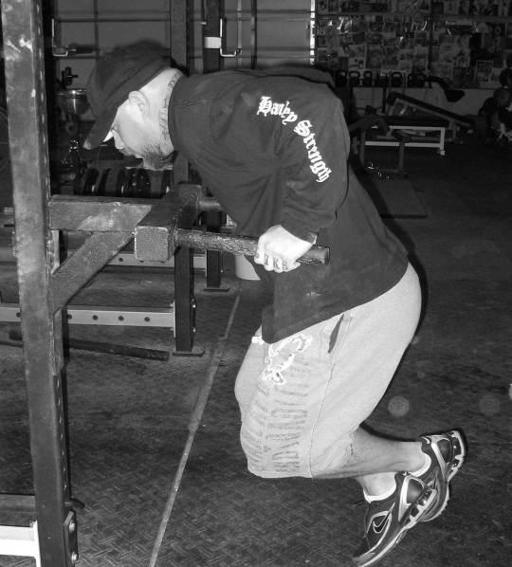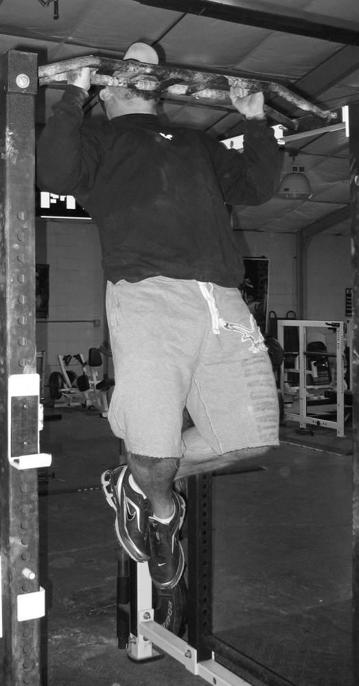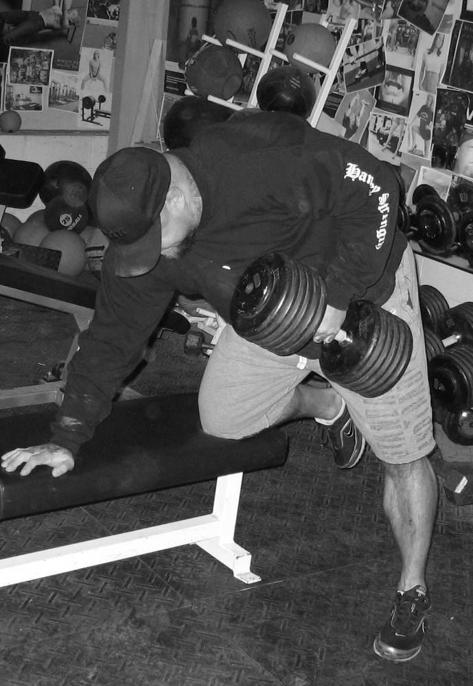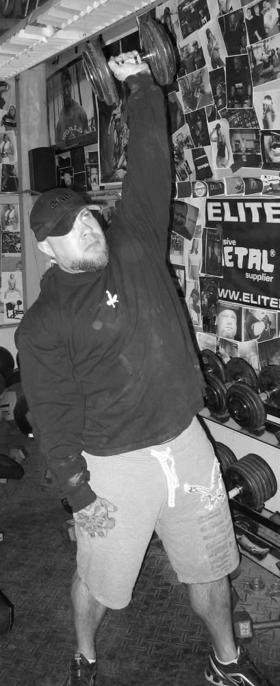5/3/1: The Simplest and Most Effective Training System for Raw Strength (2nd Edition) (5 page)
Read 5/3/1: The Simplest and Most Effective Training System for Raw Strength (2nd Edition) Online
Authors: Jim Wendler

1x5 @ 50%
1x3 @ 60%
Work sets
The purpose of a warm-up is to prepare yourself for a great day of work sets – not an average one. You real y shouldn’t need too many warm-up sets to prepare yourself for your work sets.
For a more detailed full body warm-up, see the “Moving North of Vag” section later in this book.
Comparing Rep Maxes
How do you compare your 6-rep max to your 3-rep max? How do you know which one is better?
Is your new 8-rep max better than your 2-rep max? I’ve used the fol owing rep formula since high school. It’s al owed me to assess where I am and see how my training has progressed without always having to take a true 1RM. This formula is not necessarily an accurate predictor of your 1RM, but it affords you a good general way to gauge your progress. Here it is:
Weight x Reps x .0333 + Weight = Estimated 1RM
The only constant in this formula is .0333. All the other numbers will be determined by your performance. We can try a comparison to il ustrate this. Let’s say you deadlifted 550x9 in one workout, and in another, you managed 580x5.
550 x 9 x .0333 + 550 = 715
580 x 5 x .0333 + 580 = 675
From this, we can see that the 550x9 is a stronger rep max than the 580x5. This is best used for motivation, and for a way to mental y prepare for your workouts. Let’s say you bench pressed 255x8 in your last workout. The following week, your last prescribed set is 270x3, but you want to beat last week’s performance. How do you do this? First, you need to figure out what your perceived max is for 255x8.
255 x 8 x .0333 + 255 = 322
You want to beat this max, so the next thing to do is find out how many reps, according to the formula, this will take with 270.
270 x 6 x .0333 + 270 = 323
This isn’t a huge increase, but it’s an increase, and that’s the most important thing to remember.
It’s going to take a couple of runs through to figure out what reps you’re going to need, but this wil force you to real y push on your last set. It’l give you focus throughout your day and in your training.
Having a Less than Stellar Day
You’re not always going to have great training days. Life is fil ed with distractions, and you’re going to get stressed out. Combine that with a bad night’s sleep or a lack of food, and you’re looking at a lot of things that can potential y go wrong. The bottom line here is that you’re not going to have great days all the time.
When this happens, I recommend going into the weight room with one purpose: getting your prescribed weights and leaving. The weights may feel heavy, but every part of this program is designed to build onto every other part – from one workout to the next, and one wave to the next. This week of 3x5 will earn you the right to move on to the next 3x5 week of the next wave.
Assistance Exercises
Assistance exercises accomplish four main tasks. In no particular order, they: Strengthen weak areas of the body.
Compliment and help increase the four basic lifts.
Provide balance and symmetry to your body and your training.
Build muscle mass.
The biggest problem I’ve seen with this is people doing way too much. They do too many sets, or too many exercises. These lifts should compliment the training, not detract from it. People choose exercises for every body part, train them excessively, then wonder why they’re overtrained and not making any progress. When you’re choosing your assistance exercises, do yourself a favor and justify why you’re doing them. Don’t bul shit yourself. You must have a very strong reason for doing an exercise. If you don’t, scrap it and move on. Sometimes, instead of what you do in the weight room, it’s what you
don’t
do that will lead to success.
You must keep
training economy
in mind. Training economy means getting the best bang for your buck from each exercise. That’s why squats are always better than leg extensions. There
are no right and wrong exercises, per se, but here’s a smal list of the movements I feel are best. Please note that this is
my
list, but you can certainly feel free to copy it. All of these exercises have helped me grow stronger in my four main lifts.
Dips
Figure 2: Bodyweight Dips
Dips are one of the most efficient ways to build your triceps, chest and shoulders. Many people can’t do them due to shoulder problems, but I’m not one of them, and that makes me very happy. Since incorporating these into my own training, my entire upper body has gotten bigger and my triceps are much stronger, as well.
I do recommend weighted dips, but not at the expense of form. I’d rather do ful range bodyweight dips than half-range weighted dips. The sets and reps on this exercise are dependent on your relative strength, so it’s hard to give recommendations, but since you’re going to ask:
50 total reps for weighted dips.
100 total reps if you’re just using your bodyweight.

These numbers are just recommendations, so you can do more or less depending on your strength level. If you’re ever at a loss for what to do on upper body day, do dips. Lots of them.
Chins
Figure 3: Vary your grip for every set.
Chin-ups, pull-ups, whatever. It doesn’t matter to me. Just bring yourself up to a bar and back down again. Your grip should vary: wide, medium, close, overhand, underhand, neutral. Use ropes and towels for chins to build back and grip strength.
Chins are one of the best upper back, lat and biceps exercises you can do. If you want to build your strength in these but can’t do a lot of them, try doing low reps (2-5) and multiple sets (10-20). Do this two or three times a week. They’re great to do between sets of bench and military (and squat and deadlift!) – you can do them in between any pushing exercise. You can also add weight. As far as reps go, do no less than 100 per week.

If you can’t do chins, use a Jump Stretch band to assist you. I recommend the Average Band.
Pushups
Though not as manly as the dip, the pushup still has its place in training. One drawback, however, is that pushups are hard to load. Wearing a weight vest is probably the easiest solution to this problem.
If you don’t have a weight vest – and most of you probably don’t – there are a few options you can try. First, simply do a ton of reps. Next, use rings (or EFS Blast Straps) to make the movement more difficult. You can also use chains or bands across your back to add resistance.
Blast Strap pushups (with bands) were a staple in my bench routine when I first began powerlifting. This really helped strengthen my chest and shoulders, which in turn helped the bottom of my press.
Dumbbell Rows
This is one of the best ways to build upper
back and lat strength. Kroc Rows – high
reps (20-40) with the heaviest dumbbell
you can handle – are my favorite variation.
These are humbling when you first try
them, but your grip and back strength will
quickly increase. Start off with 1-2 warm-up
sets of 10 reps, then go all-out and see
what you can do. This exercise is great for
the bench press and the deadlift, and it
helped my grip strength tremendously.
Barbell Rows
I like the dumbbell version better because it takes some of the back strain out of the movement, but there’s no denying the awesomeness of the barbel row. There are a lot of variations here, and some of them are pretty awful. The key to doing these properly – and the same holds true for any other exercise – is to figure out what you want to accomplish with the exercise. Then, you perform it in a way that accomplishes this goal.
For example, some lifters squat because they want to move the heaviest weight possible in a full range of motion (powerlifting). With squatting, for example, you improve your leverages, take an advantageous stance, descend quickly, etc. By contrast, some people squat to improve their quad mass. This lifter will squat differently.
The point here is to ask yourself why you’re doing this. Are you doing barbel rows to improve upper back and lat strength? Or are you doing them to improve your barbell row? One (the former) is based on muscles, and the other (the latter) builds a movement.
Answer this question and you will never wonder how to do a barbell row again. Like the dumbbell row, the barbell row is great for the bench press and the deadlift.
Barbell Shrugs
First things first: don’t be the guy who rol s his shoulders from front to back when shrugging.
This is a sign of a low IQ. As with the dumbbell row, I like doing these for high reps with as heavy a weight as possible. Shrugs are great for building trap size and grip strength – two things most people suck at. After one or two warm-up sets, do an all-out set of 20-40 reps.
Dumbbell Bench
I think I’ve been asked 6,000 times what kind of elbow tuck to use when performing the dumbbell bench. Palms facing? Elbows out to increase chest involvement? Something in the middle with just a slight elbow tuck?
My first response is, “It’s a goddamn dumbbel bench! Who cares!” My second response is to tell them to take the third option of a slight elbow tuck. If they want to argue with me past this, they’ve got problems.

The dumbbell bench is a great assistance exercise to strengthen the upper body pressing muscles and work each arm independently. It’s also great for the regular barbel bench press.
I’m often asked if the dumbbel bench can be used as a core exercise (to replace barbell benching or military), and the answer is no. If you want to know why, you obviously haven’t been lifting weights very long.
Dumbbell Military
Bring the dumbbells up to your shoulders. With your elbows slightly in, press them overhead.
You can press both arms at the same time, alternate, or do one dumbbell at a time. The point is simply to press the dumbbell overhead. Dumbbells offer the advantage of working each arm independently. This can show a muscle imbalance. I’ve also noticed that it sometimes shows a coordination weakness, too.
